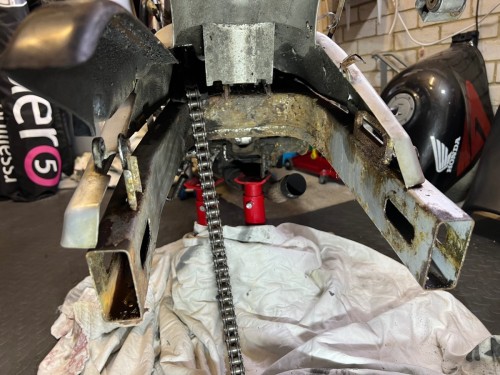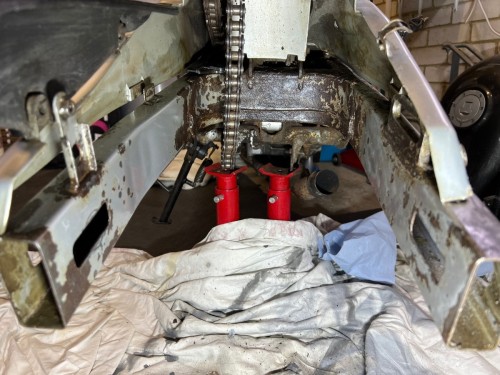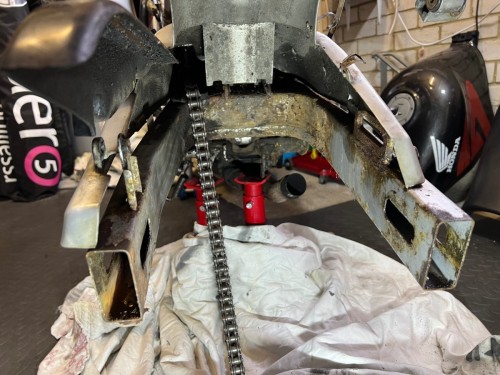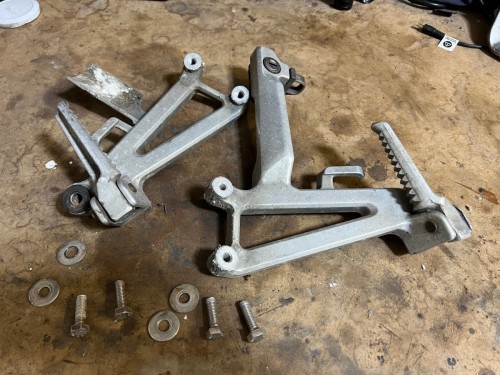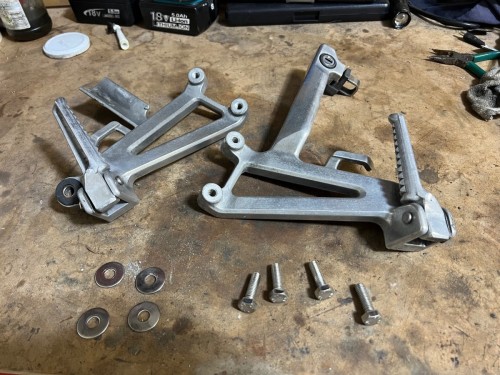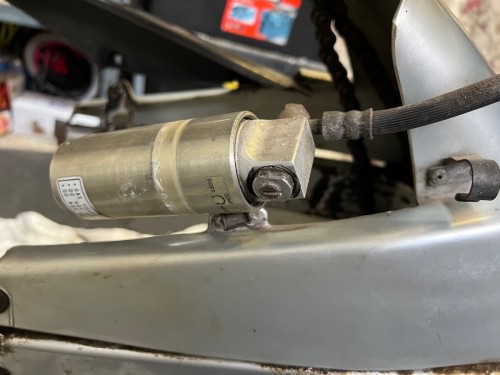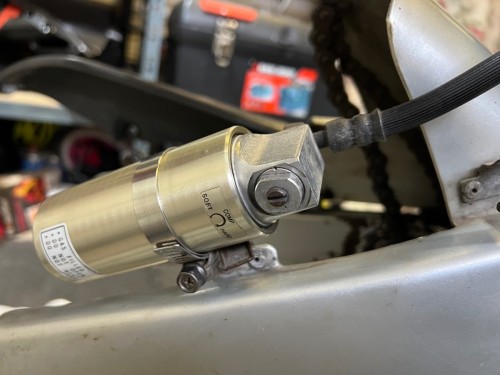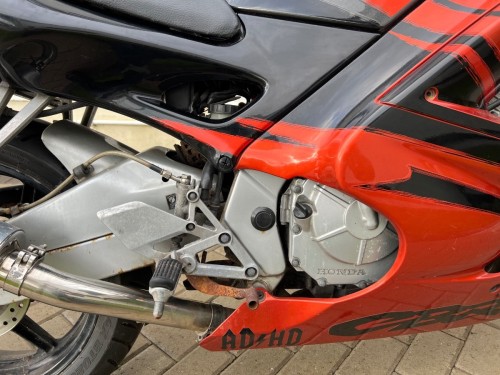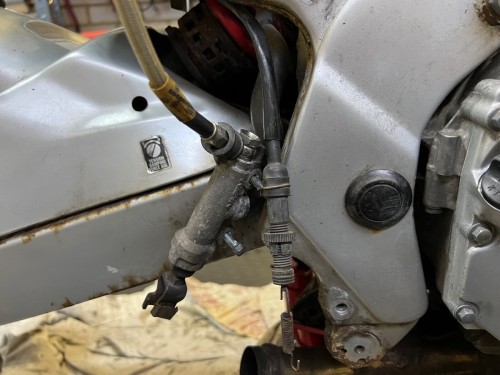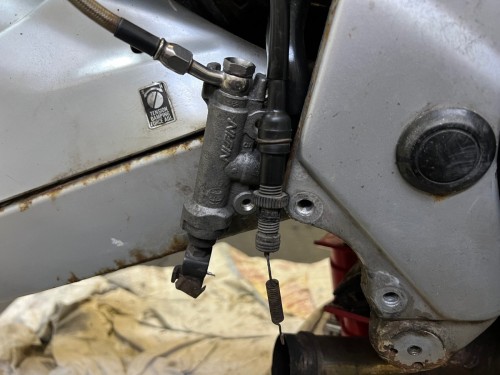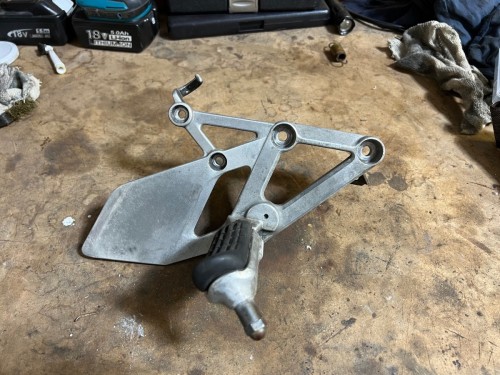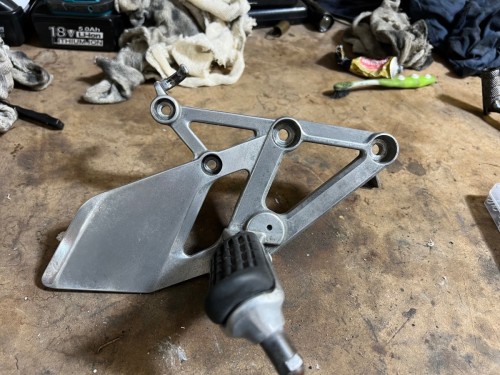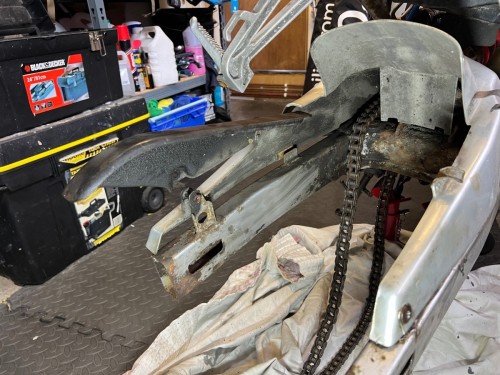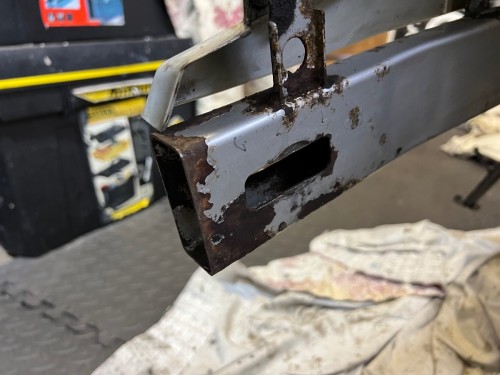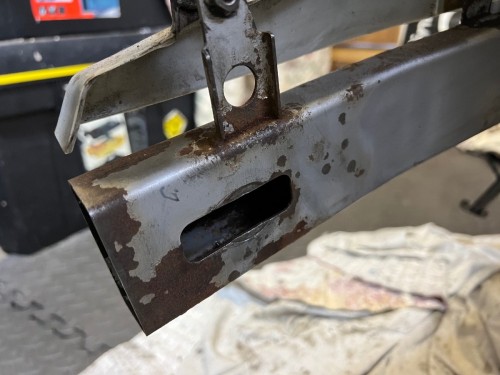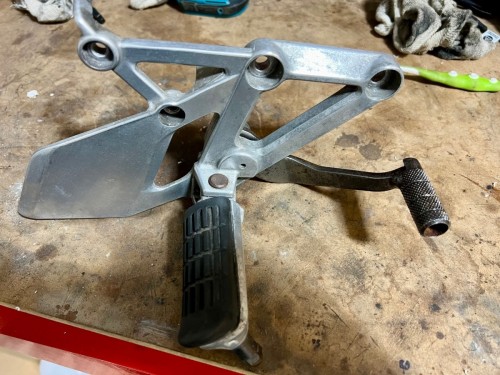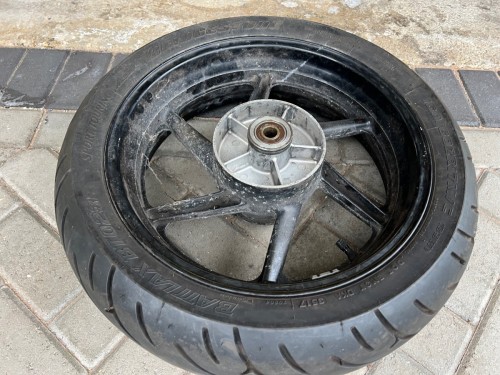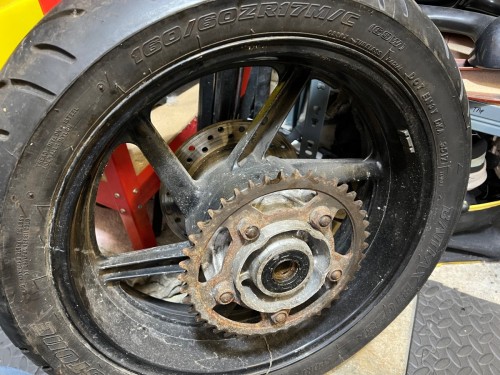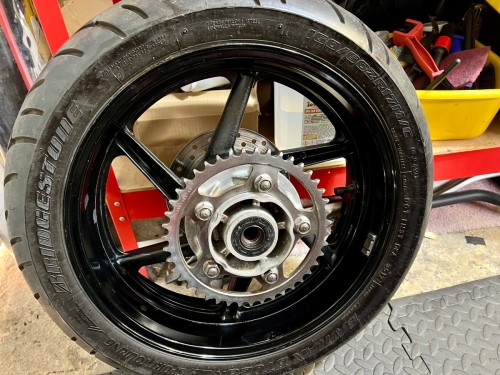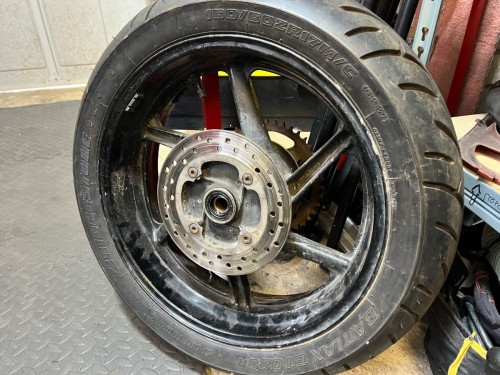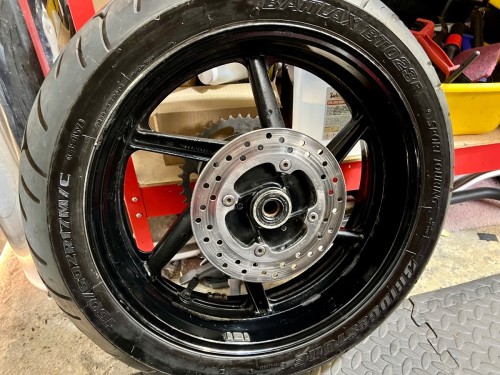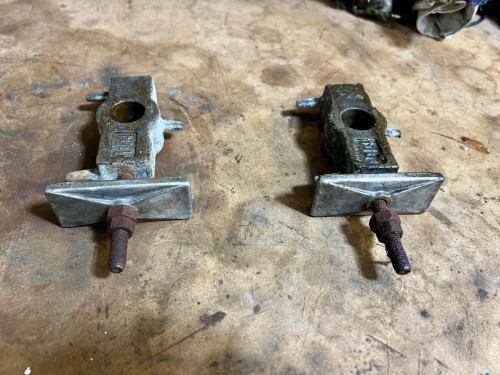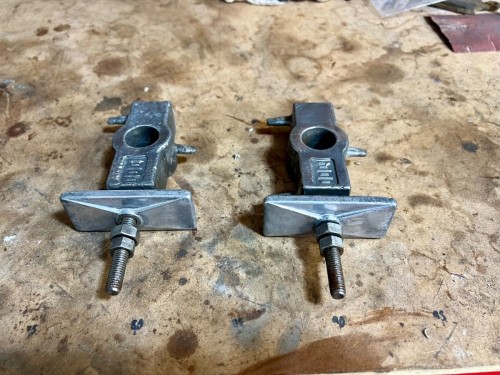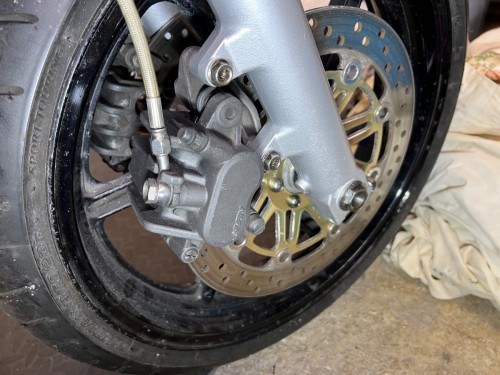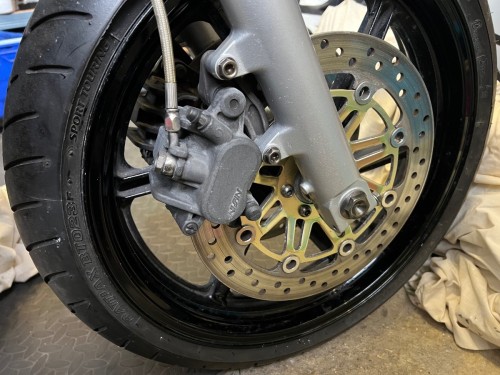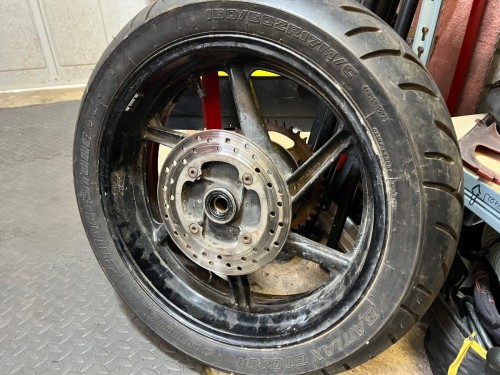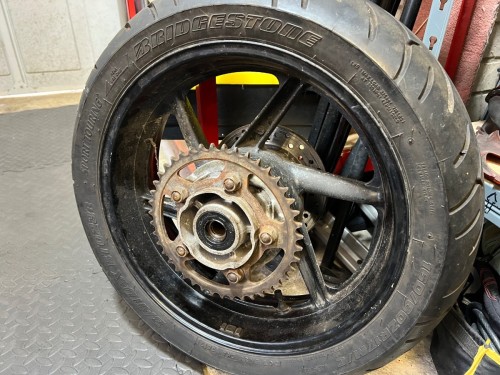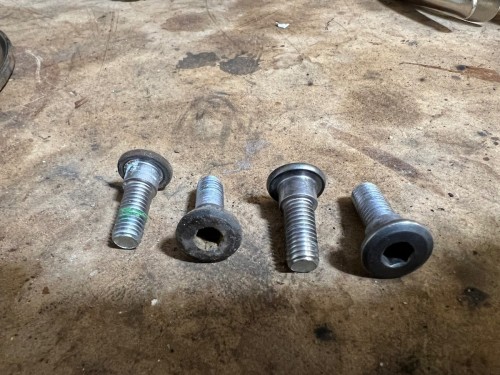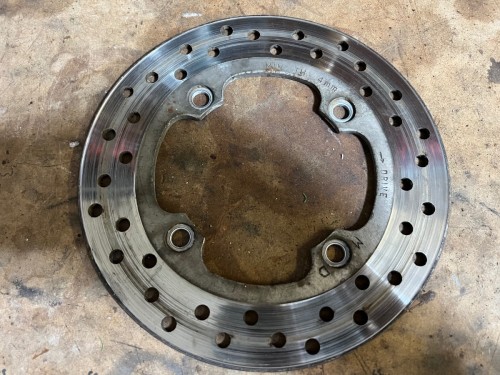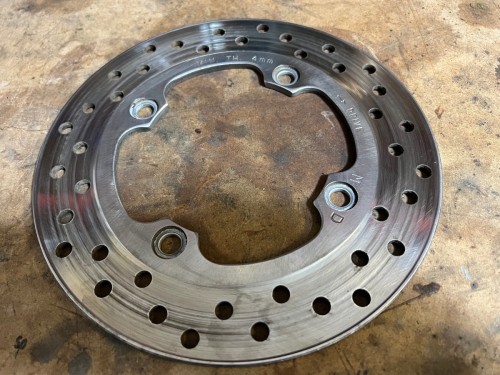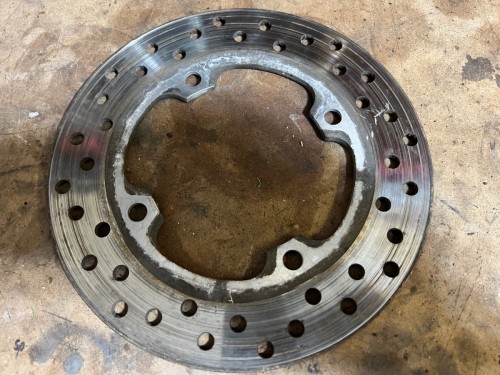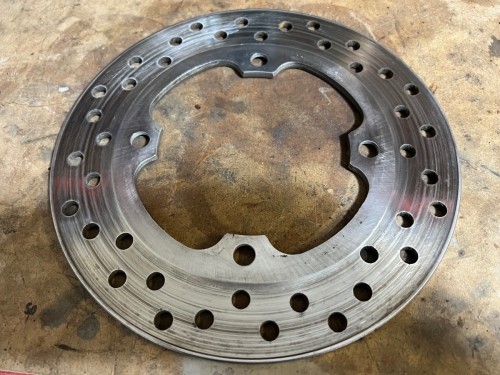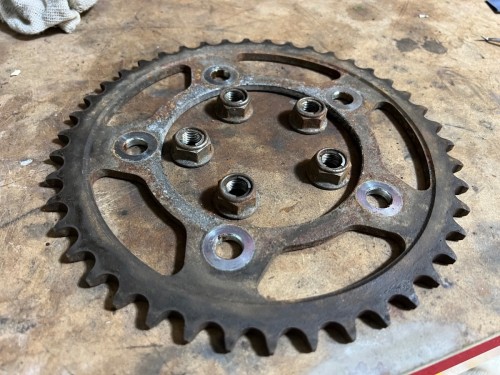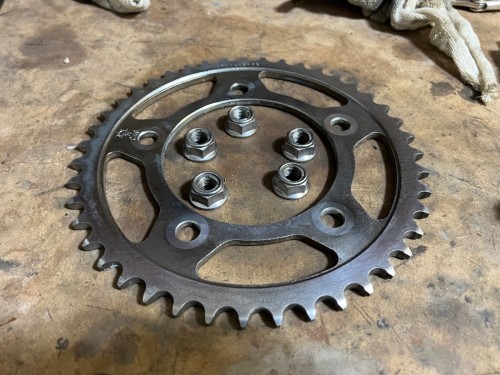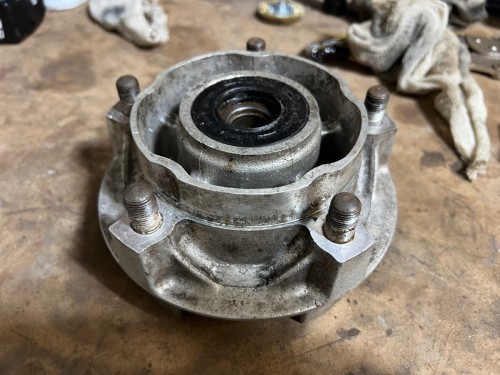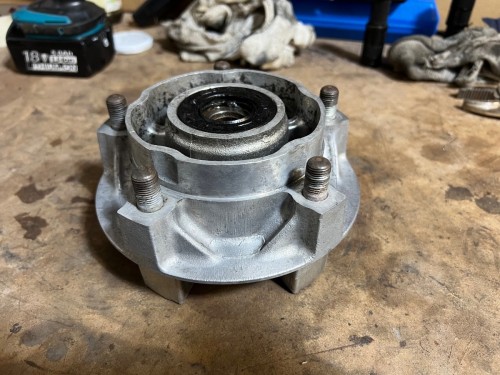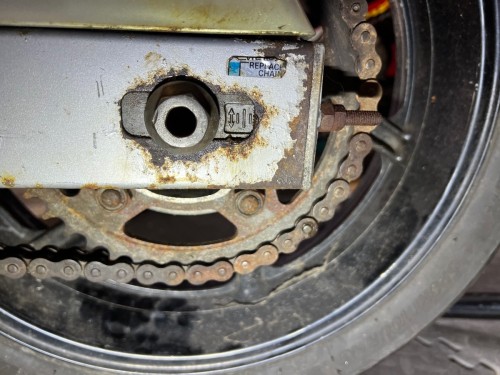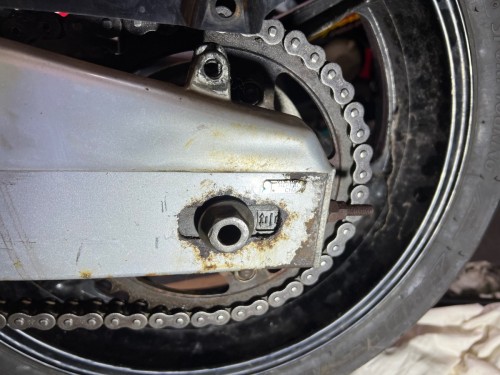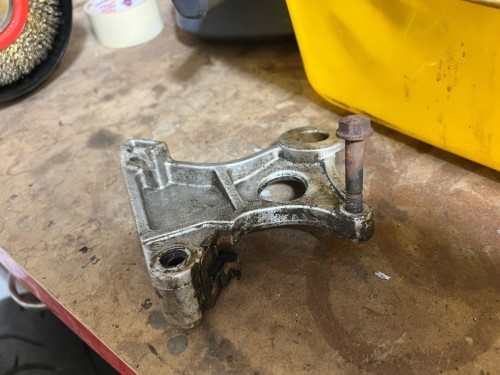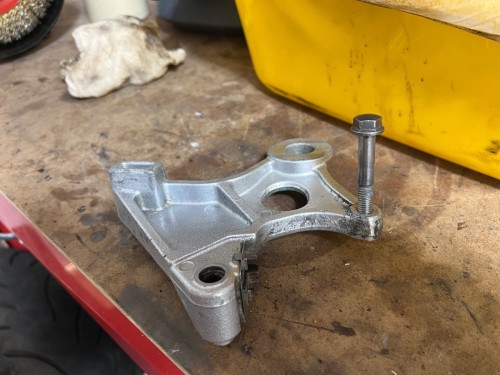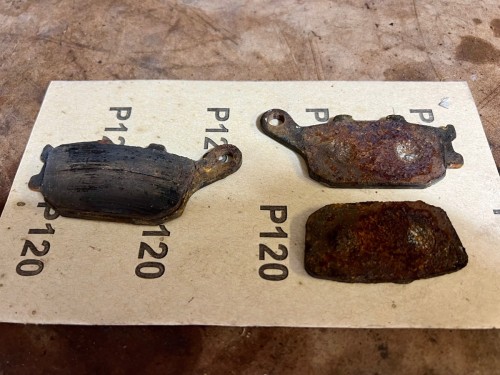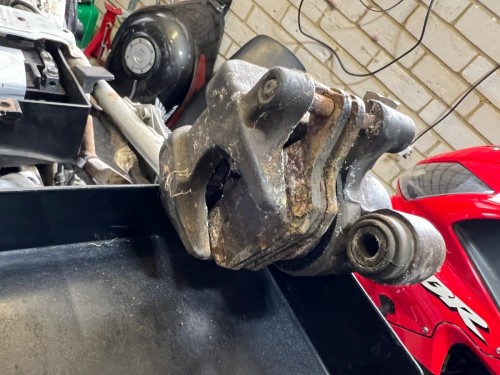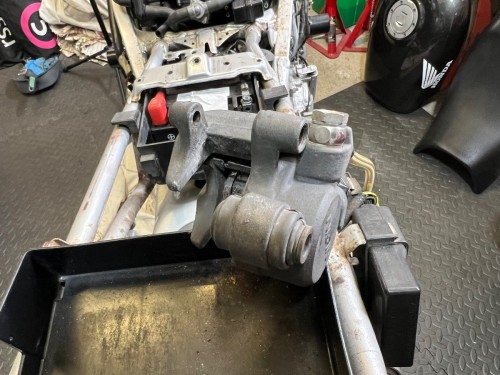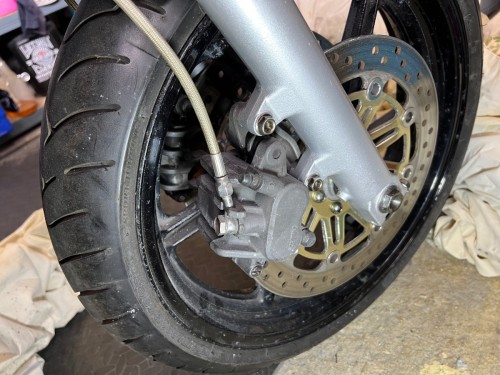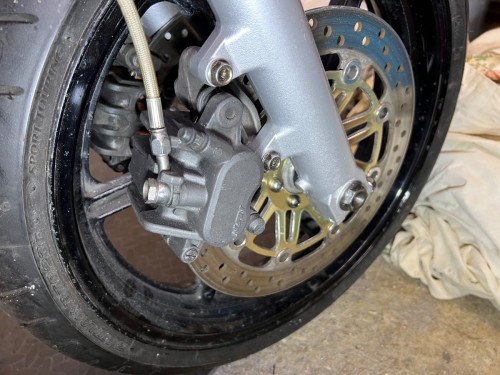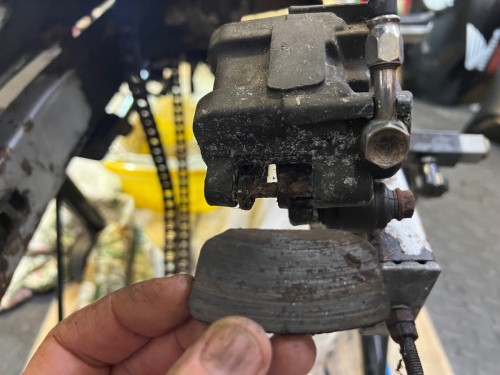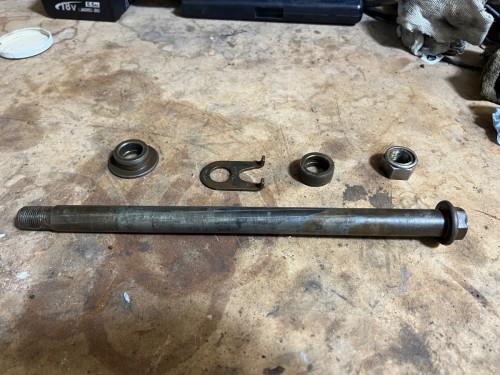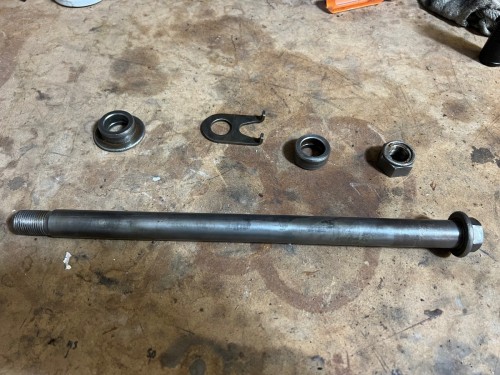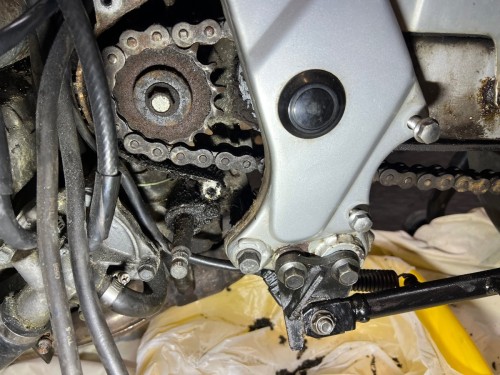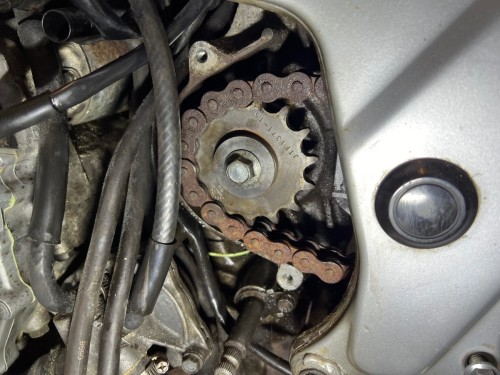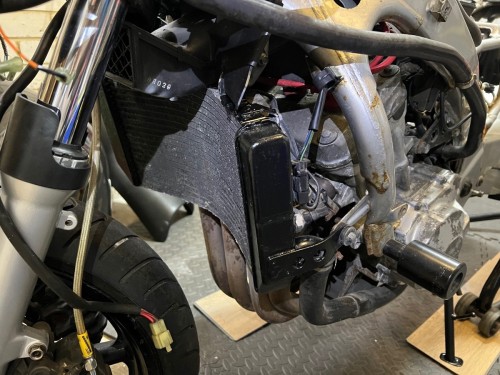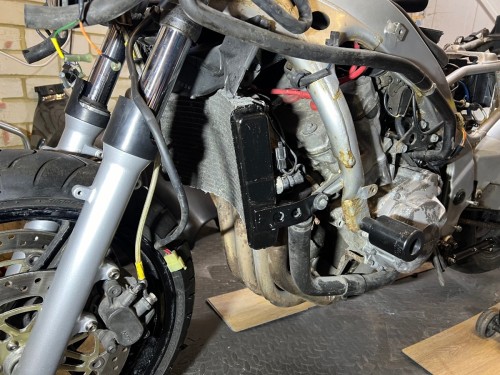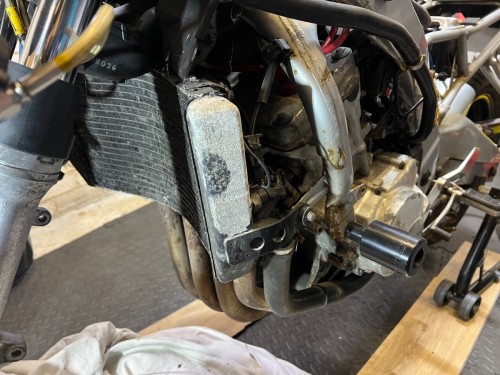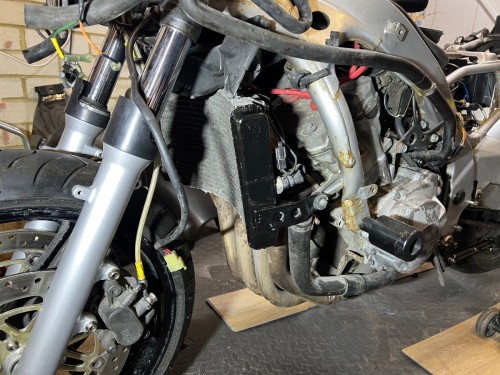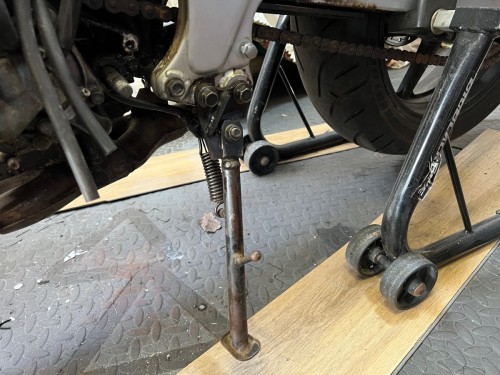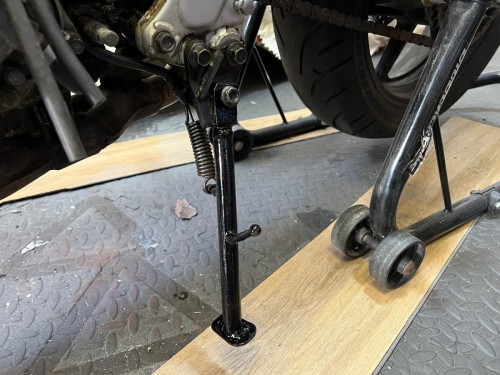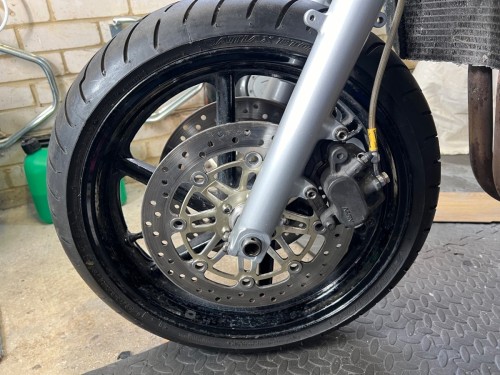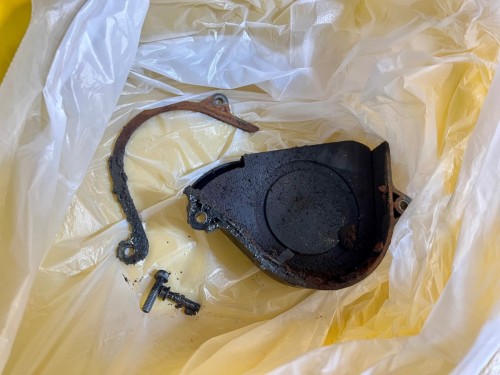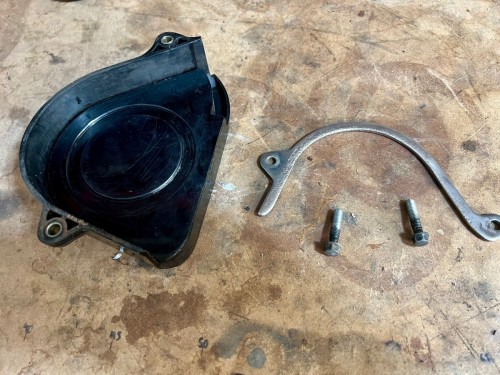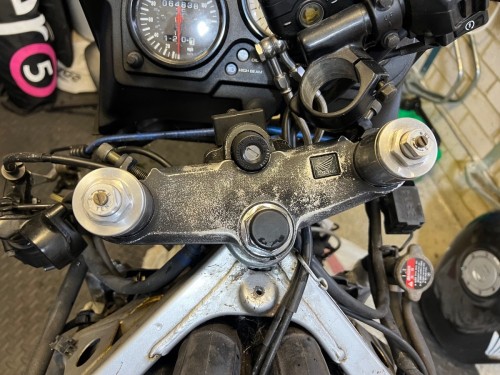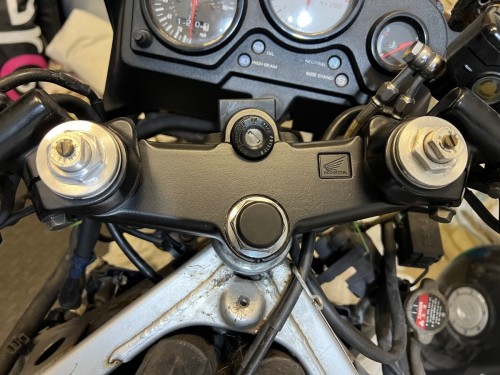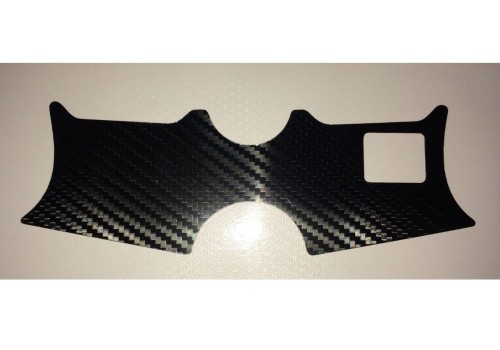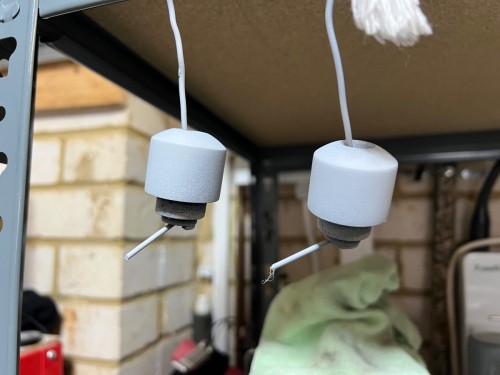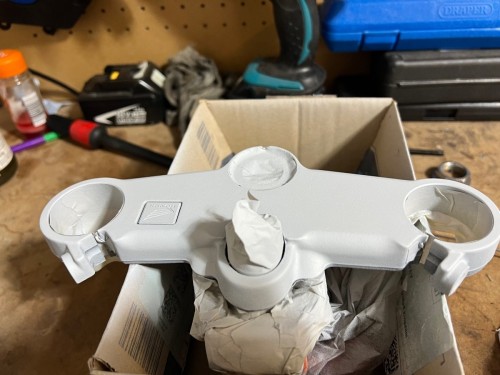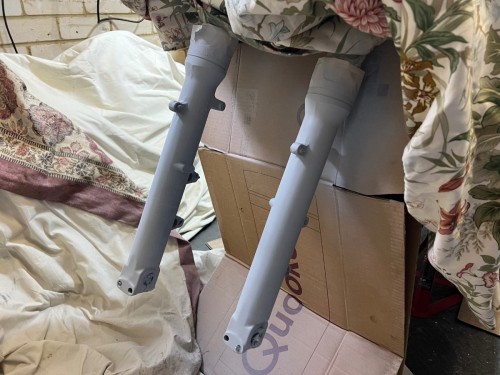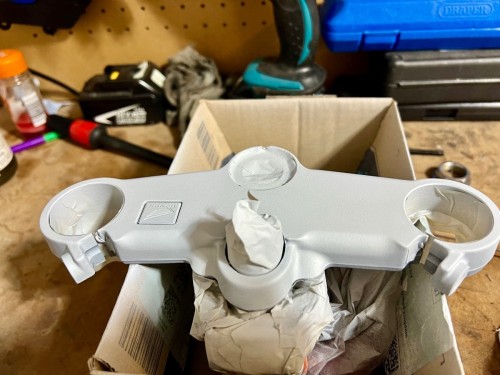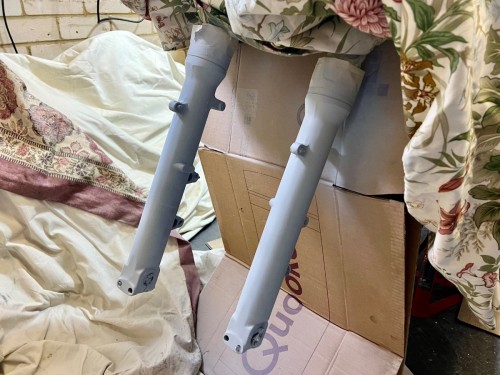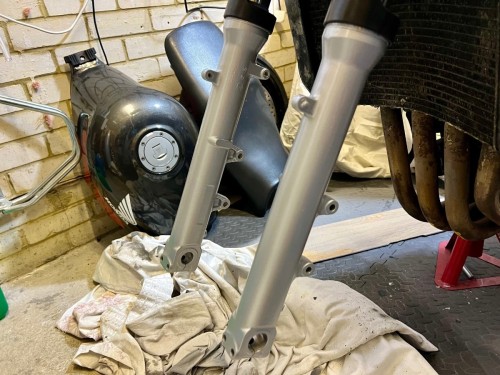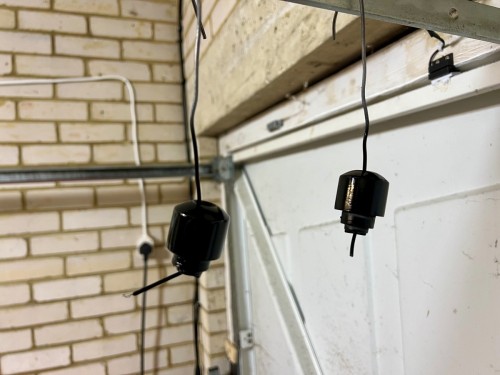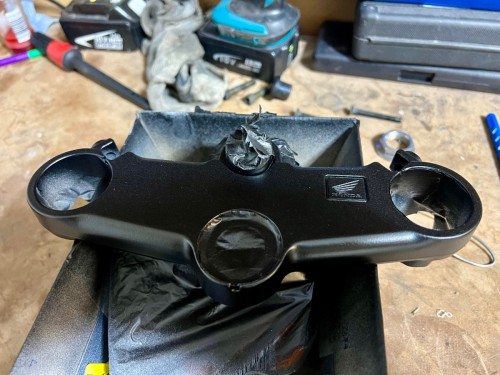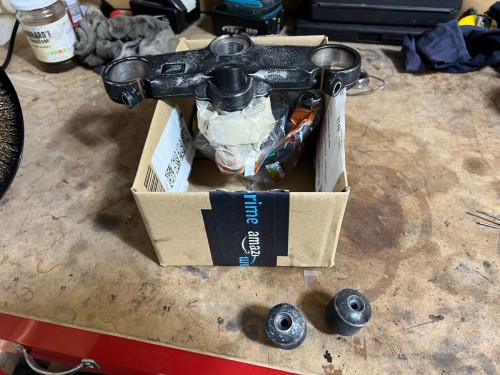-
Posts
410 -
Joined
-
Last visited
-
Days Won
7
Content Type
Profiles
Forums
Events
Store
Gallery
Community Map
Everything posted by Hairsy
-

CBR600 F3 1998 - amateur restoration
Hairsy replied to Hairsy's topic in Old Motorbikes, Projects and Restorations
Very little time to do anything on the bike today but I had another 15 minute go with paraffin on the swingarm and, finally, there's very little dirt now coming off. I think I'm getting there. In response to RideWith Styles ... Yes, you're right, if I'd removed the swingarm then I'd probably have felt compelled to change bearings too. The forks & shock really didn't look too bad. The suspension operates smoothly and without noise and the damping is effective. Although I'm no Valentino, the bike felt fine to me when I rode it. Of greater value is the view of the previous owner whose enormous shelf full of TT Mountain Course trophies gave him credibility. He talked me through how the bike rode as well as giving me an honest appraisal of areas that I'd need to look at - he wasn't simply telling me everything was great. His assessment has proved to be spot on in terms of what I've found. The view in the picture that I think you're referencing shows lots of surface rust which, I guess, is inevitable with the exposure that area has to whatever the road throws up. But I'm confident that it'll be much better following removal of the surface rust, a couple of treatments with the rust converter and then priming, painting and lacquering. Ultimately though, as I've said before, I've had to set my limit on how deep to go. In the unlikely event that I keep the bike, I'll be comfortable with what I've done and I think the level of restoration is aligned with what the bike is realistically worth. Of course the new owner is very welcome to pick up where I left off if they're inspired to do so. -

CBR600 F3 1998 - amateur restoration
Hairsy replied to Hairsy's topic in Old Motorbikes, Projects and Restorations
Well, yes, I kind of fancied it and have contemplated it. However I'm already going further than I originally intended and I've got to be a bit disciplined with myself. Although I hope the bike will end up being better than average, it's isn't going to be perfect and I need to draw a line somewhere. I did seriously consider removing the swingarm but, at that point, it would seem silly not to get it properly blasted and powder coated. And then I'd want to strip the frame and have that powder coated too. That would then lead to many other parts letting the bike down and I'd want to do something to them. Realistically, there's no way the value of the bike would financially justify all that work and I really don't want to lose money (although it may already be too late for that!). If the bike had special meaning to me then I might have gone down that road but that was never the plan. I do quite fancy a Sprint ST 1050 or perhaps a VTEC VFR800 as a keeper - so perhaps when this is done, I might seek out one of those that needs work and then that might get the full treatment. -

CBR600 F3 1998 - amateur restoration
Hairsy replied to Hairsy's topic in Old Motorbikes, Projects and Restorations
Sadly not, or at least unlikely. I already have a CBR600F and so the plan is for this one to go to a new home. The plan was always just to bring a bike back to life and learn some stuff. And hopefully someone gets a bike they'll really enjoy. I guess there's an alternative option - to keep the project bike and sell the current one. I'll see how the mood takes me. -
I'm afraid I'm not able to help regarding trailers but I can't help wondering ... Would you be prepared to offer training courses for other wives?
- 13 replies
-
- 14
-

-

-

CBR600 F3 1998 - amateur restoration
Hairsy replied to Hairsy's topic in Old Motorbikes, Projects and Restorations
Uninspiring day today but it's all progress. I set off with confidence based on the help provided above - all I need to get the degreasing done is to continue with paraffin / kerosene and finish it off with brake cleaner. I even remembered that I have a bottle of Gunk Ultra in the loft. Of course the reality is that when a bike has been unloved for a while, there is an almost unending supply of grease that just keeps appearing. So I went over the swingarm systematically, three times, constantly using fresh clean pieces of paper shop towel as soon as the last one was dirty. Even at the end of that, every new piece was getting dirty. However, I do think that most of the colour making its way onto the towel now is mostly brown from all the rust. So I think I'm getting close. I had a very quick bit of satisfying cleaning therapy when I removed the surface rust off the hugger fittings that I've given up trying to remove. Once they were clean I gave them a light brushing with XCP to keep them looking nice. Then I moved onto the removal of surface rust. I used three different shaped wire brushes for my drill plus a dremmel for the tight bits and some sandpaper for keying the rare parts that didn't have any corrosion on them. After about the 10th time of being hit in the face with a wayward bit of wire from the brushes, I made the sensible decision to put on a pair of goggles - this would have been a good idea at the start. That aside, this turned out to be a successful exercise with loads of surface rust (and bits of shed wire) deposited on the old curtain that I'd put under the bike to catch it. The slightly sad thing is that I think the swingarm now looks worse than before I started - this is definitely one of those prep steps that isn't there to make you feel good. Before and after - not really a cause for celebration. The only other thing I did today was to degrease the clutch and stator covers which I'm planning to paint at the same time as the swingarm. I've got a busy week so I'm not sure how much time I'm going to have but when I get a chance I'd like to give the swingarm another couple of goes with paraffin. It can't do any harm. And the Kurust hasn't arrived yet, which is needed before I can progress further. I'm consoling myself with the thought that this is probably the worst job left. Although the frame work, which comes next, will be a bit fiddly and time consuming, it's not going to come with the same level of degreasing. -

So, which intercom thingy should I buy?
Hairsy replied to Simon Davey's topic in Clothing, Luggage, Accessories and Security
I have Sena because it's designed specifically for my Shoei helmet but I wouldn't buy it again. The voice recognition is completely hit & miss. I took it back to the Infinity store where I bought it after a few weeks and could clearly demonstrate it being hit & miss. I was advised to try speaking at different volumes and different paces and see if that improved things. I was told they could send it back to Sena but it would be away for at least a few weeks and might well just come back with the message that They All Do That Sir. I decided to just suck it up - the Siri instructions work and that covers most of my needs. But next time I'll go Cardo. -
If I've correctly understood the original post, you're looking at a choice between CBT and buying a 125 OR working towards your A2 but not having money to buy a bike. It's some decades since I was 19 but in those days it would have been the first option every time for me - that way you get to ride. If you can afford to do A2 AND buy a bike then its a trickier decision. You can buy a second hand 125 sensibly and then, if you look after it, you shouldn't lose much money on it when you later want to upgrade. If you have mechanical skills, you could even buy one needing a little work and perhaps make a little money. It's quite easy to have lots of fun and learn loads on a 125.
-

New Motorcycle Shaped Object..
Hairsy replied to Tinkicker's topic in Old Motorbikes, Projects and Restorations
Thank you - great thread and inspirational. Looking forward to your next one. -

CBR600 F3 1998 - amateur restoration
Hairsy replied to Hairsy's topic in Old Motorbikes, Projects and Restorations
That makes perfect sense - thank you. -

CBR600 F3 1998 - amateur restoration
Hairsy replied to Hairsy's topic in Old Motorbikes, Projects and Restorations
Did a few hours work today. I'm really not sure that I feel I've made progress that reflects that amount of time. But there's always going to be days like that. I'm now onto the swingarm which, in brief, needs a lot of degreasing, a lot of surface rust removed, and then final prep and paint. First job was to put the bike onto a pair of axle stands under the centre stand mounts so that I can remove the rear stand from the swingarm. This felt like a proper progress moment - an indication that I've moved onto a new phase. Next was to remove the grease from all around the swingarm and surrounding areas. It feels as though I'm constantly degreasing but it seems never ending and there's always more. I'd already got some big clumps of chain lube off when I was cleaning the front sprocket and chain so I started off today with paraffin and a small brush on all areas with significant amounts of grease on them. But the more I cleaned, the more I found. There was a lot. Then, to get rid of the loosened grease and paraffin, I used some watered down citrus degreaser and then sprayed it with some water to wash it off. Given the amount of grease that came off, it's definitelycleaner but running my finger over areas shows that I haven't got rid of all of it yet. Which leads to a question : does anyone have advice on what to use to get ALL the grease off an area like this? I've got to get rid of it all because I'm going to be painting and that's never going to work unless everything is really clean. For now, I'll just keep repeating the cleaning process time and again but is there a better way? Or a better product? Next, in order to get easier access for cleaning and painting, I removed the pillion footpegs. They looked OK but they got a clean anyway. More importantly, they were grinding a bit when folded in and out so I took them apart and cleaned up the mechanism. That also allowed me to get rid of the rust on the pivot pin which was annoying me. They now operate smoothly. Next was another satisfying little cleanup - the remote reservoir for the rear shock. The last thing to come off was the right rider footpeg and brake pedal. This was to enable access to the front of the swingarm. I'd already removed the brake pedal when I first brought the bike home because it was incredibly rusty but there was still lots of corrosion to address so that was another half hour of stripping and cleaning. The original state of the brake pedal: The improved master cylinder and brake light switch (the effort didn't really deliver much of a difference!): And the footpeg: And with the slightly less rusty brake pedal: Cleaning alloy parts like these is quite tricky. I don't want to use power tools on them because it's very easy to add too much shine to parts like this - so it all has to be done by hand with a cloth and toothbrush. And you can't go too far with it otherwise you get too much shine. Finally, just to see how well it's going to work, I did a bit of wire brushing on the first bit of the swingarm. All seems to work fine with a wire brush in a drill - it gets rid of the surface rust and also keys the non rusty bits nicely. The coming week is going to involve quite a bit of this. Although the etch primer I'm using claims to help stop rust in future, I've decided to apply some rust converter to all the areas where I remove surface rust. It adds another step but this exercise is taking a lot of hours and so I really want to maximise the longevity of the final result. So I've got some Kurust on order and it will arrive some time next week. Please do let me have any suggestions you have on how to do the best possible degreasing job on the surfaces, prior to painting. Ideally not involving hoses and jet washes as it wouldn't be easy to move the bike outside at the moment (although not absolutely impossible if that really was the only answer). -

CBR600 F3 1998 - amateur restoration
Hairsy replied to Hairsy's topic in Old Motorbikes, Projects and Restorations
Thank you Simon - encouragement really makes a difference. And as for me doing more of this when I've finished ... no chance! -

CBR600 F3 1998 - amateur restoration
Hairsy replied to Hairsy's topic in Old Motorbikes, Projects and Restorations
Finished off the rear wheel today. First job was cleaning it. I gave it a clean with soapy water first and then used some polish to give it a harsher clean. This let me see what was under the dust and cobwebs. The answer was some decent paint but with quite a few little chips. So I cleaned off any polish residue with panel wipe and spent 20 minutes going over each side of the wheel with keen eye and a gloss black touch up pen. I left this to dry and then, based on my experience with the front wheel yesterday, I gave the whole wheel a coat of bumper trim gel. I've no idea what this stuff actually is but I really like what it does to black wheels with paint that's a little 'mature'. I was then able to put the wheel back together with the sprocket and disc. All the cleaned up fixings then got a coat of XCP Rust Blocker. Another fairly satisfying result. Tomorrow I move on to preparing the swingarm for paint but, while today's touch up paint was drying, I removed the chain adjusters and gave them the usual treatment of paraffin, clean, wire brush and autosol. They clearly take a lot of road muck spray being located where they are. The nuts took a lot of penetrating fluid and effort to remove. Even when they eventually started turning, there was heaps of frictions so I was very careful with small rotations back and forth and continued penetrating fluid. Patience is definitely a good investment with this sort of thing. And with the threads cleaned up, they now operate exactly as they should. They're not looking pristine but still much improved from how they started. One of the many lessons that I'm learning with this exercise is the importance of cleaning bikes for the benefit of their long term health. I suspect that even if this had just received some regular hosing down with fresh water then it would be in a better state. Even better, a regular application of XCP or ACF50 would mean this kind of exercise would have been SO much easier. -

CBR600 F3 1998 - amateur restoration
Hairsy replied to Hairsy's topic in Old Motorbikes, Projects and Restorations
Found it on the wheel! They were just on there. As you say, age appropriate levels of aggression. -

CBR600 F3 1998 - amateur restoration
Hairsy replied to Hairsy's topic in Old Motorbikes, Projects and Restorations
Today was a cleaning day. I like cleaning days. Stuff tends not to break. To start with I had a look at the front wheel - it looked bad in yesterday's photo of the brakes so I wanted to see whether it could be improved. Otherwise I might need to paint it. First realisation was that it's had got covered in dust since I cleaned it. This really highlights imperfections in the paint. After wiping that off I had the idea of applying some Autosol Trim and Bumper Gel to it. It's amazing stuff on black faded trim on cars and, it turns out, it does a really good job at masking age related imperfections in the finish on wheels. Definitely one to notch up to experience. Then on to the main job for the day, stripping the rear wheel. It wasn't pretty. Disc first. The bolts needed an impact driver, partly due to the length of time they've been on there and partly due to the loctite on there. It was strong stuff. I'm trying really hard to make sure fixings don't let the bike down at the end so the bolts got a clean. Two on the left of the picture aren't cleaned yet. In themselves, the improvements in things like this don't look a lot but I think it will make a significant difference at the end if there isn't corrosion on all the bolts scattered all over the bike. The disc itself is fine. I measured it and it's well within spec. It does have some grooves in the surface but it will do its job fine. However, it wasn't pretty. I worked mostly on the non swept area using a wire brush in a drill. I gave the friction surface a little going over with emery paper but it's a fairly pointless exercise as they'll clean up as soon as they used. The end result was pleasing although, as always, possibly not so clear in the photos. Onto the sprocket next. This looked really bad and I wasn't sure how well it would come out but I was determined to make the best of it. Again, wire brushes in a drill were my weapon of choice. I started off with a thin brush and went around every tooth. Laborious but satisfying by the end. Then onto both of the sides of the sprocket with a larger brush. This took perseverance and was hard work. I finished to off by applying a thin coating with Autosol polish with a rug and then rubbing it down with a wire brush in the drill. Again, that was just an idea I had and decided to experiment with it. However it worked really well at getting most of the final stubborn bits of corrosion off and I'm really happy with how it came out. Final job for today was the drive hub. Not much of this is visible when it's on the bike but I still wanted it clean. I also wanted to check the state of the rubbers (which turned out to be fine). I cleaned up the hub with paraffin first to break down the grease, then soapy water and finished it off with Autosol rubbed down with a toothbrush on the bits that will be visible. Tomorrow is a bit of a busy day but I hope to find time to clean up the wheel itself. Then it can be rebuilt with today's clean parts. And the new rear brake pads arrived today. The friction material appears to be well attached to these ones. -

CBR600 F3 1998 - amateur restoration
Hairsy replied to Hairsy's topic in Old Motorbikes, Projects and Restorations
Lots of cleaning today - and no new jobs presented themselves. So that's a win. First was the chain. It was looking like chains look when they've sat around for a few years. I'd already checked for no seized links and it didn't pull away from the sprocket so I was reasonably confident - but this project has a habit of presenting new costs when I'm not expecting them. I should have done this yesterday before removing the rear wheel! But it was easy to loosely reattach it. I started off with a wire brush to deal with the surface rust. I was slow and methodical, going for all 4 sides of the chain for the full length. This gave an immediate visual improvement. Then I painted it liberally with paraffin which seems to be the popular recommendation amongst manufacturers and gave it a good brushing with a stiff chain brush. I then rinsed off the paraffin and old lube that it had broken down. I helped this with a light spray of diluted citrus degreaser and then water. I dried it off to avoid more surface rust coming but I didn't give it new lube at this stage because I don't want a freshly lubed chain when I'm painting. I'm really pleased with the outcome - better than I expected. Then the wheel came back off again and it was time to look at the rear brake. First thing I did was to remove the caliper from the carrier and then give the carrier a clean. Then the caliper itself. And, of course, it was at this point that I realised that I should have loosened all the bolts before taking the caliper off its bracket. However I was able to crack the bolts without too much trouble. The pad retaining pins were corroded but cleaned up easily (forgot to take pictures). The pads themselves were as awful as you'd expect, given that the friction material has fallen off one of them. I'm surprised that the rear brake worked well when I took the bike out - and also very grateful. The caliper itself was filthy. However, with some brake cleaner, toothbrushes and elbow grease it cleaned up quite well. As an experiment, I finished it off with some Autosol metal polish, applied with a toothbrush. This worked really well, particularly in the nooks and crannies. Sadly the photo doesn't do it justice but it looks great. The piston had the usual corrosion that you'd expect so that needed a cleanup using some fairly fine emery paper and then very fine wire wool. It looked much better, although not pristine. Importantly though, it felt much smoother. I then pushed the piston fully into the caliper and blocked it in place with some wood. This allowed me to repeatedly apply the brake hard to see if there were any leaks. I removed the wood and pumped the piston out again (not all the way!) so that I could check for any sign of fluid making its way past the seals. There was none. Great news. The improvement to the caliper's cosmetic appearance made me go back to the front calipers, that I previously mentioned I wasn't overly happy with. I gave these a go with the Autosol and a toothbrush and they improved nicely as well. Again, I'm not sure the pictures do them justice but they definitely look much better. Tomorrow the rear wheel will get stripped and cleaning of that will start. -

CBR600 F3 1998 - amateur restoration
Hairsy replied to Hairsy's topic in Old Motorbikes, Projects and Restorations
Not the most inspiring day today but it's all progress. I got underneath the swingarm with a wire brush and some paraffin to check whether the surface rust and years of chain lube were hiding anything sinister. They weren't. Everything is structurally sound. Just not terribly pretty under there. I did a similar job around the front sprocket which always gets mucky when neglected. There was plenty of old grease there but not quite as much as I expected. Someone must have given it a clean up in the past. I didn't take pictures because, at this point my hands were disgusting. Then on to the rear wheel and today's revelation about the bike. I think I mentioned previously that the brake pads all have plenty of life in them but I still wanted to remove them all to check for crumbling material or any other issues. Well, when I removed the rear wheel, the friction material from one of the rear pads simply fell off! The pad backing plate was still in the caliper but the friction material was on the floor! So I'm fairly pleased that I checked. I'll order new pads in a few days when I've given the caliper a proper clean - I'll need to make sure that the rest of the caliper is serviceable and I don't need other parts. The rear axle and associated hardware were covered in surface rust and grease. I took the first picture after giving them a first wipe down so they're already better than when I first removed them. The second picture is after a more thorough cleanup. All in good condition underneath the muck and very much re-usable. The rear hugger fixings have been soaking in penetrating fluid for over a week now but still won't budge with the impact driver. The only way to remove the hugger will be to drill the fixings out. If I do that, it will be a heap of hassle, risk of making a mistake (I'm not experienced with doing that) and then all I would do is put it back in place as there's no reason to remove it because I can reach everything I need to without removing it. So it's going to stay in place and I'll work around it. Final thing today was to order a new petcock. I've been procrastinating on this in the hope that it will improve further as it's used. However I know that if I was keeping the bike then I'd fit a new one. And I want to sell it in a condition that I'd be happy with. So there's one on its way now. Oh, and one more thing. The look of the radiator after I'd painted it last week was bugging me so over the weekend I painted a bit more of it and cleaned up a plastic trim that's near it. And, in my opinion, it's now much better. It will of course still be completely hidden when the fairings are in place but I'll know! Before and after -

1979 Yamaha DT175mx.
Hairsy replied to Tinkicker's topic in Old Motorbikes, Projects and Restorations
Thanks for sharing this project. Entertainment and education - what more could we ask for. Sorry to read of your other frustrations today! -

CBR600 F3 1998 - amateur restoration
Hairsy replied to Hairsy's topic in Old Motorbikes, Projects and Restorations
Not at this stage. The forks operate smoothly and feel well damped. I chatted with the previous owner (a successful racer) and through those conversations I trusted him when he told me the bike rode well. I’ve also taken it for a short test ride myself. This project is about taking an unattractive non runner and making it into a good 26 year old bike that will suit someone and have had all its immediate needs met. It’s not a full restoration. I’ll deal with anything mechanical that needs it but, financially, the bike is never going to be worth enough for me to spend money on things that aren’t actually needed right now. It’s almost certainly going to be sold at a loss but I’ll have had a productive winter and a (mostly) enjoyable experience. As a bonus, hopefully someone will ride off with a smile on their face. That’s not to say I’m not going to do mechanical things that are truly needed. For example, the brakes work fine but I’m definitely going to renew the fluid as it’s sat in there for 4 years. I also replaced the fuel pump when my repair proved to be unreliable. And, of course, the MoT could spring a surprise - but I hope not. One day I’d love to do a full on restoration, but I’m afraid this isn’t that bike. -

CBR600 F3 1998 - amateur restoration
Hairsy replied to Hairsy's topic in Old Motorbikes, Projects and Restorations
Absolutely - but I'm trying not to think about that bit until after next week! -

CBR600 F3 1998 - amateur restoration
Hairsy replied to Hairsy's topic in Old Motorbikes, Projects and Restorations
Today was going to be a quick one - just a quick hand paint of the sidestand and radiator and then put the front wheel and brakes back on. Although nothing went wrong, today was a good reminder that things generally take longer than you think and it was the best part of a couple of hours in the end. First job was a final clean of the bits I was painting today and then a brush paint with some Hammerite Smooth. I know it's not the best paint ever but it's easy and goes on without primer. For parts which aren't 'on show' but need a little tidy up then I think it does the job. Having said that, I'm not sure I like the effect on the radiator. The picture actually makes it look worse as the reflections of light in the imperfections on the surface make it look as though I've missed bits. It is actually fully covered but it's a bit shinier than I'd like. In practice, none if this is visible when the fairings are on - this was just one of those things that I couldn't bear to leave in the state I found it, despite the fact that I'm the only one who'd ever know. Well, apart from you lot! The sidestand looks good though. Next was putting the front wheel and brakes back in place. This went much more smoothly than when I removed them, now that everything has been properly cleaned up. Everything was torqued up correctly and it was satisfying to see it all functioning correctly. I'm considering having a go at cleaning up the calipers a bit more later. They looked good when they were the only clean bit but now that everything else is looking better they let the side down a bit. But I have to constantly remind myself of my goal with this bike and I think I should try to resist the temptation to do more. I'll see how they look once the bike's back together. Finally, my first job next week will be to wheel the bike outside and give the swingarm and rear frame area a good degrease and clean up before I start working on the rear brakes, wheel and any other problems I discover at the rear. With that in mind, I removed the cover off the front sprocket, just in case it turned out to be another part that didn't want to come off. It actually came off very easily but what a load of caked on muck! But also, what a satisfying clean up job. I have a bit of thing about cleaning parts - it's so therapeutic. That's it for this week. Very pleased to have got the first paint jobs out of the way and the front end back together. Next week will be all about rear brakes and swingarm area. And also another chance to look at whether it's worth me trying to remove the hugger. Thanks for all the suggestions and encouragements. They do help. -

CBR600 F3 1998 - amateur restoration
Hairsy replied to Hairsy's topic in Old Motorbikes, Projects and Restorations
Never heard of that before but just had a quick look and it's definitely interesting - will take a closer look. -

CBR600 F3 1998 - amateur restoration
Hairsy replied to Hairsy's topic in Old Motorbikes, Projects and Restorations
I've taken the decision that I'm not going to matt lacquer the triple clamp. I'll probably put some sort of protective sticker on it. So I've put it back in place. I like it! -

CBR600 F3 1998 - amateur restoration
Hairsy replied to Hairsy's topic in Old Motorbikes, Projects and Restorations
Just found this as a potential plan B for the triple clamp https://www.ebay.co.uk/itm/285436737494?hash=item42755af7d6:g:5zAAAOSwol5YzW8T&amdata=enc%3AAQAIAAAA8Hv16sSaURy5lRFJa6HTpBcZ7U0vunLPjA8ULch%2FFI4SERAsaQ%2F1qUxGNoUp7p5fxZXYsW%2BzF9trhjQl069JOHX9THeqAlPsRDG9AN6CjwFEAp3cT%2BKpXQ%2BIHuesMsSSgMeG%2B6QHnfxdsM%2FmSA4J%2FUmWmj8laQCQaTnTJxK1EkhHRWeOP21tayWwX50e%2BKvHAX20gJlPgg6N29uK%2B1boM0lxE8tnjIhG4W7S9fcRacaO%2B0xBoXBkEl%2BF2YZ%2BlkmYH6IDXAlGlwzRwHI8bqi9PVrxONUINreECKH7X%2F2W1JsBdJlQWERbnk1XVpQbdUEZ8g%3D%3D|tkp%3ABk9SR5j2j5ioYw -

CBR600 F3 1998 - amateur restoration
Hairsy replied to Hairsy's topic in Old Motorbikes, Projects and Restorations
So today was the big day where I got the paint cans out. This was a nervous day for me - I’ve never felt comfortable with anything related to bodywork or paint. Many times in the past, I’ve followed instructions but lacked the experience / skills to really do a good job. It’s frustrating when you spend ages prepping and then have an unsatisfactory finish. The panel wipe arrived this morning. I started by decanting equal amounts into a squirty bottle and all over my bench because I didn’t stop pouring when the bottle was full - idiot. I gave the bar ends, triple clamp and forks a really good final clean with the panel wipe. Using a white piece of rag, it was clear that despite numerous previous attempts at cleaning, there was still muck on there. I then completed final masking, wiped over with a dry microfibre cloth to get rid of last particles and applied the etch primer. I haven’t used etch primer before and it seemed to take really well. I’d planned three coats but everything was looking great after two so I left it there. After waiting for the primer to dry, I was on to Matt Black for the triple clamp and bar ends and Wheel Silver for the forks. I haven’t used Simoniz paints before but they seem to coat better than others I’ve used. I don’t know whether that’s the prep, the primer, something mechanical like the nozzle they use or the paint itself - but applying the paint was very satisfying. Another wait after the base coat and I then added 3 coats of lacquer to the forks and bar ends. I’m delighted with the forks - huge thanks to Tinkicker once again for his recommendation of the paint. Putting the lacquer on the bar ends was an experiment to see what matt black and lacquer ends up like. I was hoping for a slightly satin finish but it’s actually full on gloss. This is OK for the bar ends but I want the triple clamp to reman matt so I’m glad I didn’t do the same with them. But that leaves me with a dilemma - do I leave the triple clamp with just the lovely matt painted finish or should I try to apply a matt lacquer? When the triple clamp is in situ it's well protected from the elements but if someone had a big set of keys in the ignition then a coat of lacquer could help to protect the finish from scratching. Even though the bike’s going to get sold when it’s done, I’d really like everything to stay nice. I can get a can of Hycote Matt Lacquer from the local Euro Car Parts. But does it really leave a matt finish? Amazon reviews suggest it's more satin than matt and some people report it messing up the paint underneath. I really don't want it to get a shine and / or to mess up the paint underneath and need to be re-done. I really don’t know what to do. Any suggestions? Despite numerous attempts, I can't seem to remove these last 2 images. Apologies! -

CBR600 F3 1998 - amateur restoration
Hairsy replied to Hairsy's topic in Old Motorbikes, Projects and Restorations
In the interests of showing that this kind of project includes mundane days, a small unexciting update. Mostly because house decorating called for my time. Removed the top of the triple clamp. I had planned to paint in situ but that's never going to give the best finish and it only took a few minutes (most of which was taking photos of the ignition switch cable routing so that I put it back correctly later). Once off I was able to do a little more sanding in the crevices and figure out how to hold it for painting. Just need to mask off the ignition switch and inner surfaces once it's had the final degrease. I also removed the bar ends which weren't in a terrible state but, I hope, would have let the side down once it's all finished. Gave them a quick rub down and they're now ready for some paint. One day I'd love to do a 'proper' restoration where I replace old parts but at least this one is keeping me out of mischief through the winter.


